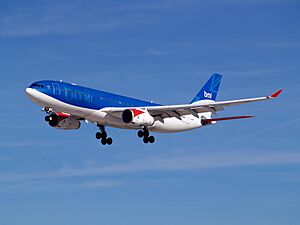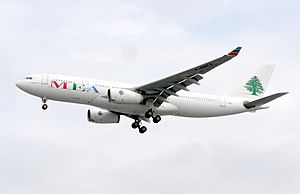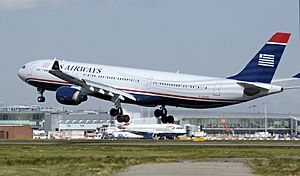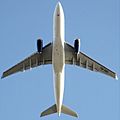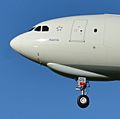Airbus A330 facts for kids
class="infobox " style="float: right; clear: right; width: 315px; border-spacing: 2px; text-align: left; font-size: 90%;" ! colspan="2" style="text-align: center; font-size: large; padding-bottom: 0.3em;" | Airbus A330 |-
|- | colspan="2" style="text-align: center;" |  |- |colspan="2" style="border-bottom: 1px solid #aaa;text-align:center;" |Air France A330 at Charles De Gaulle Airport |-
|- |colspan="2" style="border-bottom: 1px solid #aaa;text-align:center;" |Air France A330 at Charles De Gaulle Airport |-
! Role | Wide-Body Jet airliner |- ! National origin | Multi-country origin |- ! Manufacturer | Airbus |-
! First flight | 2 November 1992 |- ! Introduction | 17 January 1994 with Air Inter |-
! Status | Being produced and used by airlines |- ! Primary users | Turkish Airlines
Cathay Pacific
Delta Air Lines
China Eastern Airlines |- ! Produced | 1992-present |- ! Number built | 1016 as of 10 October 2013 |-
! Unit cost | A330-200: US$216.1 million(€160 million) (2013)
A330-300: US$239.4 million(€177 million) (2013)
A330-200F: US$219.1 million(€162 million) (2013) |- ! Developed from | Airbus A300 |- ! Variants | Airbus A340 |-
|}
The Airbus A330 is a large, two-engine jet plane made by Airbus. It's known as a "wide-body" aircraft because it has two aisles inside, making it feel very spacious. It was designed at the same time as the Airbus A340, so they share many parts, like their body and wings.
The A330 first flew in 1992. The first one was given to Air Inter in 1994. This was a longer version called the 300 series. Soon after, Airbus made a shorter version, the 200 series. Airbus also created a cargo version (for carrying goods) in 2001 and a tanker version (for carrying extra fuel to refuel other planes in the air) in 2007.
Many A330s are still being built and delivered to airlines around the world. Most of these new planes are the shorter 200 series.
Contents
Building the A330
Airlines needed new planes to replace their older McDonnell Douglas DC-10 aircraft. So, in 1987, Airbus started working on two new planes: the A330 and the A340. It turned out that the A330 uses almost 38% less fuel than the old DC-10. This makes it much more efficient.
Airbus designed the A330 to fly long distances, even over large oceans where airports are far away. In 2009, the A330 was the first plane to get a special approval called ETOPS-240. This means it can fly up to 240 minutes (4 hours) away from any airport. This is very useful for flights over big oceans or places like the Antarctic.
The A330's main body (called the fuselage) and wings are very similar to the smaller versions of the A340. However, they use different engines. The A330's body also looks a lot like the older Airbus A300. Its computer systems, like the fly-by-wire system (where computers help the pilot control the plane), are similar to those in the Airbus A320 planes. Both the A330 and A340 are built in the same factory in Toulouse, France.
The 1000th A330 was ordered by Cathay Pacific at the 2008 Farnborough Air Show. Airbus plans to keep building the A330 for many more years.
Types of A330 Planes
There are two main types of Airbus A330: the 200 series and the 300 series. There are also special versions for carrying cargo or fuel.
A330-200
The A330-200 was made to compete with Boeing's 767-300ER plane. It is a shorter version of the A330-300.
In the 1990s, Airbus wasn't selling many A340-200s. So, they took the body of the A340-200 and added the wings and engines of the A330-300. This new plane, the A330-200, was much more popular because it was more efficient.
The tail fin (called the rudder) of the A330-200 is a bit taller than the 300 version. This helps it fly smoothly.
The A330-200 can carry more fuel than the A330-300, which means it can fly further. It has a range of about 12,500 km (6,750 nmi).
Airlines can choose from three different engine types for the A330:
- Two General Electric CF6-80E engines
- Two Pratt & Whitney PW4000 engines
- Two Rolls-Royce Trent 700 engines
A330-200HGW
In 2009, Airbus announced plans for a version of the A330-200 that could take off with a heavier weight. This version was designed to compete with Boeing's 787-8.
This new A330-200HGW can fly even further, with a range of about 13,300 km (7,200 nmi). Korean Air was the first airline to order this version.
A330-200F (Freighter)
The A330-200F is a special version designed to carry cargo instead of people. Airbus created it to replace older cargo planes like the A300-600F and A310F. It was first shown in 2006 and flew for the first time in 2009.
This plane can carry 64 tonnes of cargo over 7,400 km (4,000 nmi). It has a new loading system that makes it easier to put cargo inside.
It also has a special front landing gear system. Normally, the A330-200 points slightly downwards when on the ground. This is good for pilots to see, but it makes loading cargo harder. The new gear makes the plane sit straight, so cargo can be loaded easily. It has a small bulge under the nose to make space for this new gear.
A330 MRTT (Tanker)
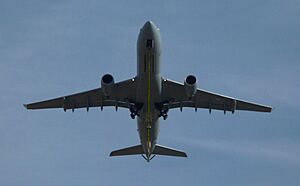
This version is a military tanker aircraft. It carries a lot of jet fuel to refuel other planes while they are flying. It can also carry some passengers.
Countries like Australia (for the Royal Australian Air Force), the United Kingdom (for the Royal Air Force), the United Arab Emirates, and Saudi Arabia use this plane.
The A330 MRTT was also considered by the United States Air Force to replace some of their older tanker planes. However, after some discussions, they chose a different plane.
A330-300
The A330-300 was the first type of A330 to start flying in 1993. It was made to replace the Airbus A300. It has a similar body to the A300-600 but features new wings and systems. It competes with Boeing's 777-200 and 767-400ER.
This plane can carry about 295 passengers in a typical setup with different seating classes. It can fly up to 10,500 km (5,650 nmi).
Like the A330-200, airlines can choose from the same three types of engines: General Electric CF6-80E, Pratt & Whitney PW4000, or Rolls Royce Trent 700. These engines allow the A330-300 to fly up to 180 minutes away from an airport where it could land safely.
Airlines Using the A330
About 80 different airlines and companies currently use the A330. Some of the airlines with the most A330s include:
- Cathay Pacific from Hong Kong
- Delta Air Lines from the United States of America
- Emirates Airline from the United Arab Emirates
- Qatar Airways from Qatar
- Air China and China Eastern Airlines from China
Incidents and Challenges
The A330 has been involved in several incidents, including some where planes were damaged beyond repair. Here are a few notable events:
- In 1994, an A330 owned by Airbus crashed during a test flight after takeoff.
- In 2000, a Malaysia Airlines A330-300 was damaged by a corrosive liquid that was being carried as cargo. The liquid was wrongly labeled as safe.
- Also in 2000, a Philippine Airlines A330-300 was hijacked. The hijacker jumped out of the plane and did not survive, but everyone else on board was safe.
- In 2001, two SriLankan Airlines A330-200s were destroyed at an airport in Sri Lanka during an attack by a group called the Liberation Tigers of Tamil Eelam.
- Later in 2001, an Air Transat A330-200 flying over the Atlantic Ocean had a fuel leak. Both engines stopped working. The pilots managed to glide the plane for 19 minutes and land it safely at an air base in the Azores. Two passengers had serious injuries, but everyone survived.
- In 2003, a Dragonair A330-300 flew through very strong turbulence over the South China Sea. Several crew members and passengers had minor injuries, but the plane landed safely.
- In 2008, a Qantas A330-300 experienced a computer error that caused the plane's nose to suddenly point down twice. This led to injuries for many people on board, but the pilots landed the plane safely.
- In 2009, Air France Flight 447, an A330-200, crashed into the Atlantic Ocean while flying from Brazil to France. Everyone on board died. Investigations showed that the co-pilot accidentally put the plane into a stall.
- Also in 2009, a Northwest Airlines (now Delta Air Lines) A330-300 was almost attacked with a bomb by a passenger. The bomb did not explode properly, and passengers and crew stopped the attacker.
Related pages
- Airbus A300
- Airbus A340
- Airbus A350
- Boeing 767
- Boeing 777
- Boeing 787
- McDonnell Douglas MD-11
Images for kids
-
Compared to the A330 twinjet (on ground), the heavier A340 (inflight) has four engines and a centre-line wheel bogie
-
A330 final assembly line in Toulouse, 2007
-
The A330-200F freighter was first delivered to Etihad Cargo in July 2010
-
The fly-by-wire A330/A340 retains the A320's six-screen glass cockpit.
-
The initial variant, a 63.7 m (209 ft) long A330-300 of Cathay Pacific, its largest operator. The aircraft pictured was the aircraft in Cathay Pacific Flight 780.
-
The first 242 t (534,000 lb) A330-300 was delivered to Delta Air Lines in May 2015
-
Airbus A330 MRTT/KC-30 of the RAAF with refuelling drogues deployed
-
The vertical stabilizer recovered from Air France Flight 447
See also
 In Spanish: Airbus A330 para niños
In Spanish: Airbus A330 para niños


